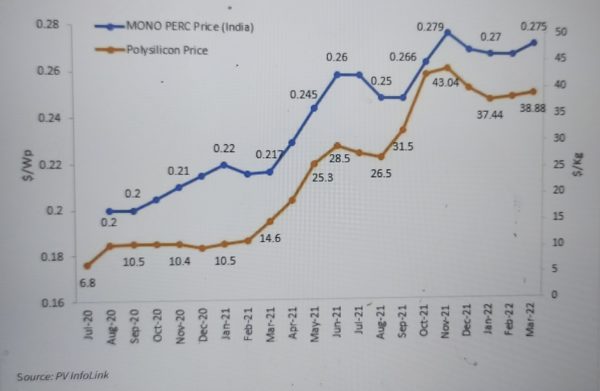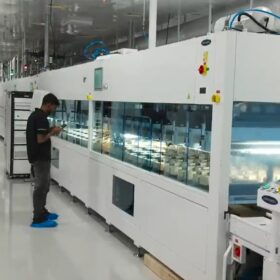In the past decade, the world has witnessed a solar boom. Annual solar installations across the globe have increased from 18 GW in 2010 to 183 GW in 2021 and is projected to increase to 334 GW by 2030. Similarly in India, the cumulative installed solar capacity has increased manifold from 161 MW in 2010 to 42 GW as of December 2021.
One major reason for such a large-scale adoption of solar is its low cost. On a Levelized Cost of Electricity (LCOE) basis, solar has become the lowest cost electricity generation source in several major countries. In India, tariff discovered in utility scale solar tenders have fallen from INR 10.95/kWh in 2010 to INR 1.99/kWh in 2020, which is significantly lower than INR 5-7/kWh tariffs for new thermal power projects.
A major driver of such a downtrend of solar tariffs has been solar modules, which contributes 62-67% of the total project cost and their price/Wp have consistently fallen over the years. Average monthly global solar module (crystalline) price fell from $2.649/Wp in 2010 to $0.192/Wp in July of 2020. This represents an approximate 23% year-on-year fall in module prices in the same period. It was an inherent assumption of all stakeholders that this trend will continue. Thus, the solar developers could easily put this number in their financial models and bid aggressively in solar tenders predicting cheaper solar modules by the time project procurement begins.
Unfortunately, since the mid of 2020, solar module prices have become increasingly unpredictable and volatile. In a complete reversal of the previous trend, solar module prices (mono PERC) in the global market actually increased from August 2020 to November 2021 by 42%. On similar lines, solar module prices (mono PERC) in India also increased from August 2020 to November 2021 by 40%.

Source: PV InfoLink
Key reasons for increasing solar module prices in India and abroad are:
- Supply chain disruptions – Polysilicon is the critical raw material in solar PV manufacturing. Its reduction in price over the years has been the major factor contributing to decline in solar module prices. However, post July 2020, polysilicon price in the global markets increased from $6.8/kg to $43/kg in November 2021 (six times increment). Upon observing the overall price trend of modules and polysilicon together (refer the figure), the impact and influence of the rise in polysilicon price over the module price is clear. Other disrupting factors in the PV supply chain include price hikes for commodities such as glass and metals, shortage of containers etc. Such disruptions were exacerbated further due to various Covid-19 induced lockdowns across the world which resulted in halting of manufacturing activity.
- Augmentation of demand – Supply demand mismatch is another major factor contributing to increase in solar module prices. Over the past two years, the demand and acceptance for solar worldwide has exploded. The demand for cheaper and cleaner sources of energy, with corporates globally setting up decarbonizing and Net Zero goals, is further driving the growth of demand of solar. In such a scenario of demand outstripping supply, price of the concerned commodity increases.
- Impact of basic customs duty (BCD) and Approved List of Models and Manufacturers (ALMM) – From April 2022 onwards, BCD will be applied on import of solar modules (40%) and cells (25%). Additionally, government mandated solar developers to only use ALMM enlisted modules for government projects, government-assisted projects, those under government schemes and programs (e.g., Component A of PM-KUSUM scheme) as well as open access and rooftop net metering projects. ALMM so far, only contains domestic manufacturers. Anticipating upsurge in demand for domestically manufactured solar modules due to above factors, the leading domestic solar manufacturers have increased their prices by 3-4 cents (viz. 3-4%) between February and March 2022.
- Miscellaneous – During Q3 CY2021, several countries including China faced an energy crisis. Main reasons were shortage of coal and associated supply chain disruptions in coal supply. The solar manufacturing industry, still highly concentrated in China, was affected by the rolling blackouts implemented by the government of the energy intensive industries. This crisis compounded an already difficult situation and contributed to increase in module prices in short term. With covid cases surging in China post March 2022, the Chinese government has imposed strict lockdowns across several major provinces. Thus, this hindrance to solar manufacturing in China may affect solar module prices at least in the short term.
Reviewing the points mentioned above in detail, supply demand mismatch turns out to be most crucial factor which is directly or indirectly leading to increase in module prices. At present, demand far outstrips the supply (especially poly-Si). Balance between the supply and demand is essential for stabilization of solar module prices. COP26, held in Glasgow in November 2021, wherein ambitious country wise RE targets were set. Ongoing conflict in eastern Europe have also highlighted the need for Energy Security and self-sufficiency. Thus, the demand and hunger for solar is not likely to come down anytime soon.
With ever increasing demand, it is imperative for supply to catch up to stabilize solar module prices. However, setting up a new poly-Si factory is capital and time intensive. It takes a minimum of 18-24 months construction time for a new poly-Si production facility. Since the poly-Si prices have shot up during 2021, several new projects have been announced. Indian government is also targeting vertically integrated solar manufacturing through its Production Linked Incentive (PLI) scheme. It is expected that these new facilities will start production by mid-2023 at the earliest.
Including domestic factors of BCD, ALMM implementation to the geopolitical and supply demand mismatch, it can be concluded that solar module prices are not expected to come down anytime soon. Considering all factors, it is expected post late 2023 or Q1 2024 is the period when we may finally see downward trajectory in solar module prices again.
The views and opinions expressed in this article are the author’s own, and do not necessarily reflect those held by pv magazine.
This content is protected by copyright and may not be reused. If you want to cooperate with us and would like to reuse some of our content, please contact: editors@pv-magazine.com.








1 comment
By submitting this form you agree to pv magazine using your data for the purposes of publishing your comment.
Your personal data will only be disclosed or otherwise transmitted to third parties for the purposes of spam filtering or if this is necessary for technical maintenance of the website. Any other transfer to third parties will not take place unless this is justified on the basis of applicable data protection regulations or if pv magazine is legally obliged to do so.
You may revoke this consent at any time with effect for the future, in which case your personal data will be deleted immediately. Otherwise, your data will be deleted if pv magazine has processed your request or the purpose of data storage is fulfilled.
Further information on data privacy can be found in our Data Protection Policy.